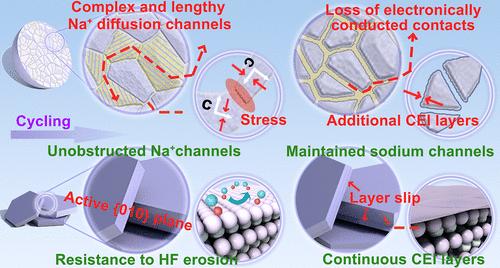Enabling High-Voltage and Long Lifespan Sodium Batteries via Single-Crystal Layer-Structured Oxide Cathode Material
IF 16
1区 材料科学
Q1 CHEMISTRY, MULTIDISCIPLINARY
引用次数: 0
Abstract
Manganese-based layer-structured transition metal oxides are considered promising cathode materials for future sodium batteries owing to their high energy density potential and industrial feasibility. The grain-related anisotropy and electrode/electrolyte side reactions, however, constrain their energy density and cycling lifespan, particularly at high voltages. Large-sized single-crystal O3-typed Na[Ni0.3Mn0.5Cu0.1Ti0.1]O2 was thus designed and successfully synthesized toward high-voltage and long-lifespan sodium batteries. The grain-boundary-free single-crystal structure and unidirectional Na+ diffusion channels enable a faster Na+ diffusion rate and high electronic conductivity. Meanwhile, the large-area exposed (003) crystal plane can not only exhibit a higher energy barrier for electrode–electrolyte side reactions but also alleviate the interlayer sliding and structural collapse during charge–discharge processes. The lattice oxygen in contact with the electrolyte was stabilized, and the TMO6 octahedral structure integrity was maintained as well. A high specific capacity of 160.1 mAh g–1 at a current density of 0.1 C was demonstrated. Coupled with hard carbon as the anode, the full cell can also demonstrate an excellent capacity and cycling stability, achieving a high specific capacity of 141.1 mAh g–1 at 0.1 C. After 100 cycles at 2 C, the capacity retention rate is 97.3%.

利用单晶层状结构氧化物正极材料实现高电压长寿命钠电池
锰基层状结构过渡金属氧化物具有高能量密度潜力和工业可行性,被认为是未来钠电池极具前景的正极材料。然而,晶粒相关的各向异性和电极/电解质副反应限制了它们的能量密度和循环寿命,特别是在高压下。设计并成功合成了用于高压长寿命钠电池的o3型大尺寸单晶Na[Ni0.3Mn0.5Cu0.1Ti0.1]O2。无晶界单晶结构和单向Na+扩散通道使得Na+扩散速率更快,电子导电性更高。同时,大面积暴露的(003)晶面不仅可以为电极-电解质副反应提供更高的能垒,还可以减轻充放电过程中的层间滑动和结构崩塌。与电解液接触的晶格氧得到了稳定,并保持了TMO6八面体结构的完整性。在0.1 C电流密度下,具有160.1 mAh g-1的高比容量。再加上硬碳作为阳极,整个电池也可以表现出优异的容量和循环稳定性,在0.1 C下达到141.1 mAh g-1的高比容量,在2 C下循环100次后,容量保持率为97.3%。
本文章由计算机程序翻译,如有差异,请以英文原文为准。
求助全文
约1分钟内获得全文
求助全文
来源期刊

ACS Nano
工程技术-材料科学:综合
CiteScore
26.00
自引率
4.10%
发文量
1627
审稿时长
1.7 months
期刊介绍:
ACS Nano, published monthly, serves as an international forum for comprehensive articles on nanoscience and nanotechnology research at the intersections of chemistry, biology, materials science, physics, and engineering. The journal fosters communication among scientists in these communities, facilitating collaboration, new research opportunities, and advancements through discoveries. ACS Nano covers synthesis, assembly, characterization, theory, and simulation of nanostructures, nanobiotechnology, nanofabrication, methods and tools for nanoscience and nanotechnology, and self- and directed-assembly. Alongside original research articles, it offers thorough reviews, perspectives on cutting-edge research, and discussions envisioning the future of nanoscience and nanotechnology.
 求助内容:
求助内容: 应助结果提醒方式:
应助结果提醒方式:


